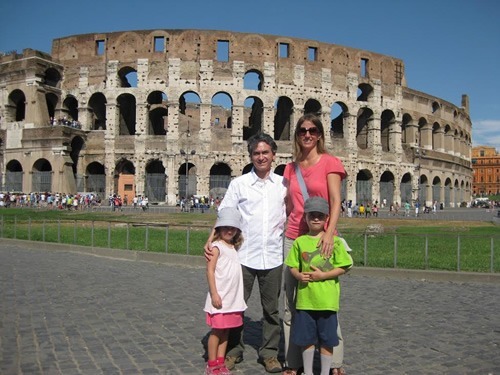Educational Family Travel: Apply Tips for Rome Anywhere
Article and photos by Amy E. Robertson

|
|
Author with family in front of the iconic Roman Colosseum.
|
I’m American, my husband is from Italy, and our family has lived in three other countries over the past 11 years. In short, our family travels a lot. Not all of our trips are “educational” — in fact, we hope that our kids don’t feel that any of them are. Because educational travel isn’t about memorizing facts or listening to long-winded explanations. For me, educational travel is about connecting — the past to the present, history and foreign cultures to actual experiences and people.
One of our regular destinations is Italy, where Nonna, my kids’ grandmother, lives. Italy can be a fantastic family-friendly travel destination: what kid doesn’t like gladiators and gelato? But making the most of the trip requires thinking through a few points. From managing logistics to connecting to the culture, here are a few tips from our trips to Italy that can be adapted to any destination.
1. Study Up Before Traveling
Adults have years of learning under our belts to help us contextualize and understand new information and experiences. Kids don’t have that. But rather than, say, lecturing our kids on the history of Ancient Rome during a visit to the Colosseum, we try to paint a picture in advance through fun books and films, so that those images in their heads come to life when they see the real deal. We also try to find guidebooks that are as appealing for the kids to browse through as they are for us, so that they can get excited about the destination and help shape our plans. Here are a few suggestions for Rome:
Younger Children
Magic Tree House #14: Ancient Rome and Pompeii (non-fiction) .The Magic Treehouse series also has fiction books about Pompeii and Leonardo da Vinci. Author and illustrator Tomie dePaola has several picture books set in Italy that recount folktales and beliefs.
Suggested guidebook: This is Rome by M. Sasek. This picture book is a guide to Rome that even the youngest can enjoy.
Middle Grade
Who Was Julius Caesar? (non-fiction) This fantastic series includes notes on the history and culture of the time, as well as the biography. (Other Italian luminaries in the series include Leonardo Da Vinci, Galileo and Christopher Columbus; there is also a What Was Pompeii?) Britannica Kids: Ancient Rome is an app for your phone or tablet that you don’t have to feel guilty about. Perfect for the plane ride over, or to pull out when standing in line.
Suggested guidebook: Not For Parents Rome: Everything You Ever Wanted to Know (Lonely Planet) Chockablock with fun facts and plenty of pictures.
Teens
The movies Gladiator and Spartacus aren’t without historical inaccuracies, but in terms of helping to envision a gladiator battle or a chariot race, they can’t be beat.
Suggested guidebook: DK Eyewitness Travel Guide: Rome While not specifically aimed at any particular age group, the endless pictures and easy graphic layout of DK guides make them more appealing for anyone not interested in slogging through text (like an impatient teen).
2. Look for Accommodations that Can Connect You with Locals
Making the most out of your trip means choosing your accommodation carefully. Options that offer the chance to interact with locals can help pull back the curtain between you and your destination. And, of course, any place that can offer a little more elbow room is a boon to a traveling family.
There’s no better way to connect with locals than by finding a homestay. They are often significantly cheaper than booking a room for three or more in a hotel, with the added convenience of access to a kitchen for warming a baby bottle or preparing a snack. A quick look at Homestay.com shows two bedrooms (sleeping 4) available in an apartment centrally located by Termini Station for just $159 total, or a room sleeping 4 persons in an apartment with a family with teens for $136.
Another alternative is to look at hotels that follow the European tradition of a pensione. A traditional pensione is a boarding house, typically a large old home whose bedrooms have been converted into guestrooms. Nowadays, the term pensione has been expanded to refer to B&Bs and sometimes small boutique hotels, but the common thread is that they retain a personal touch, typically with friendly owners that are happy to share their local knowledge. Check out Bed and Breakfasts Rome or a more curated list of nine top B&B picks in Rome for some options.
As far as location is concerned, the obvious advantage of a central stay is that you cut down on transportation time. But for those willing to stay just outside of the central core, the reward isn’t just lower prices. Your family may be the only foreigners that you see walking around your neighborhood, shopping in the market, or dining in the local restaurants.
3. Finding Ways to Engage and Ways to Relax

|
|
Put your hand in Rome's Bocca della Veritá (Mouth of Truth) to test your truthfulness. A big hit with daring kids.
|
Traveling is fantastic, but it can also be exhausting, especially in a city like Rome where you walk, walk, walk, walk, walk. We have a two-pronged approach to keeping the kids (and thereby the parents) happy.
First, anything interactive or multimedia gets priority.
This doesn’t mean that we give up on the boring-to-them but fabulous-to-us sights (like Caravaggio paintings in the church San Luigi dei Francesi…), but we try to make sure that each day of sightseeing has one or two activities that are kid-friendly, as kids are much more about doing than just observing (unless of course we’re talking about TV.)
Rather than reading from our guidebook about the important works of the Vatican Museums when we visited, we spent the few extra euros to take audioguides. The Vatican offers audioguides targeted at kids age 6-12, with a map pointing out the most kid-friendly works in the museum (animals, Egyptians and naturally, the Sistine Chapel). Both entrance tickets and audioguides can be booked online, and I strongly recommend you do so to avoid hours of waiting in line with impatient kids.
In the vein of looking for treasures, I also suggest bringing a copy of the book Mission Rome: A Scavenger Hunt Adventure. Don’t scavenger hunts make just about anything more fun?
To learn more about life in Ancient Rome, we visited Le Domus Romane of Palazzo Valentini on our last trip, where ruins of ancient Roman houses were excavated beneath a medieval palace. Light projections and sound effects help visitors envision what once was. Note that while tickets can be purchased the same day, only guided visits are allowed, so it’s worth checking ahead of time to make sure you get the language and time slot you prefer.
There are some 40 catacombs scattered outside of the walls of Rome, and in addition to the thrill of the creepiness factor, descending into their murky coolness can be a welcome relief after sightseeing under the warm Roman sun. Transitions Abroad’s first columnist Rick Steves names the Catacombs of St. Callixtus as his favorite, and they’re conveniently located near the end of the Appian Way, another nice place to walk from the hustle and bustle of downtown Rome.
Second, we are all about taking breaks.
Anyone with good study habits will tell you that it’s important to take regular breaks. If you’re busy running from one sight to another like a guidebook author with a checklist to complete, you have no time to allow what you’ve seen sink in, to absorb what’s around you. (Trust me on this, as a guidebook author, I know.) Allow for down time, especially when traveling with kids. When our kids were younger, we found making a daily stop at the local park could make the difference between a good vacation and an exhausting one. It can also be a way to meet local families. In Rome, the enormous Villa Borghese is conveniently located near the Piazza del Popolo, and there are parks and piazze sprinkled throughout the city.
4. Build Deeper Connections
How can the kids put what they’re experiencing into practice? One way is through workshops, and many major destinations now offer kid-friendly versions. Take the go-to Roman rest stop of a visit to an ice cream shop a step further by signing up to learn how to make ice cream, pizza, mosaics, or how to fight like a gladiator with family and kid-friendly Walks Inside Rome: Kids and Families Tours
tours.
Connecting with the culture and people is of course easier if you know some of the local language. If you have enough time to take a few lessons, check out this a long list of language schools in Italy, as well as tips on how to choose a good language schools. (To the list of questions to ask, I’d add one about how many families or children they’ve taught in the past year.) There are also myriad resources for picking up a few words of a foreign language before heading off on your trip. Some public libraries have language CDs and books aimed at kids that you can borrow; online a good starting point for family-friendly language-learning, and there are many options. Learning even a few words can go a long way to break the ice, especially in Italy where the locals are enthusiastic about foreigners who try to speak their language.
If you’ve picked up enough language skills to muddle through a simple conversation, another way to connect could be through a volunteer opportunity. Romaltruista offers short-term volunteer opportunities for activities such as providing snacks and meals to the hungry, or spending a couple of hours taking care of street cats. Opportunities show up just a week or two in advance.
When in Rome… or Russia or Rio de Janiero…
While these tips are Rome-specific, the principles can be applied to any destination. Whether your next trip is to Rome, Italy or Rome, NY, to Russia or to Rio, take the time to connect and transform your family from tourists to travelers.

|
Amy E. Robertson has written many articles for TransitionsAbroad.com as Connected Traveler Contributing Editor.
She is the author of numerous publications for Moon Handbooks. Her writing has been published on NPR, Vice MUNCHIES, Budget Travel, Delta Sky, National Geographic Traveler, Wall Street Journal, Christian Science Monitor and Travel + Leisure, among others.
Amy has lived in six countries and traveled in more than 60.
Her volunteer experiences include building houses in Washington State and Honduras, monitoring presidential elections in Ecuador, working with youth on social documentaries in Bolivia, and serving lunch at soup kitchens in Seattle and Beirut.
Amy has a background in international development and nonprofit management and has worked in both the private and nonprofit sectors.
|
|
